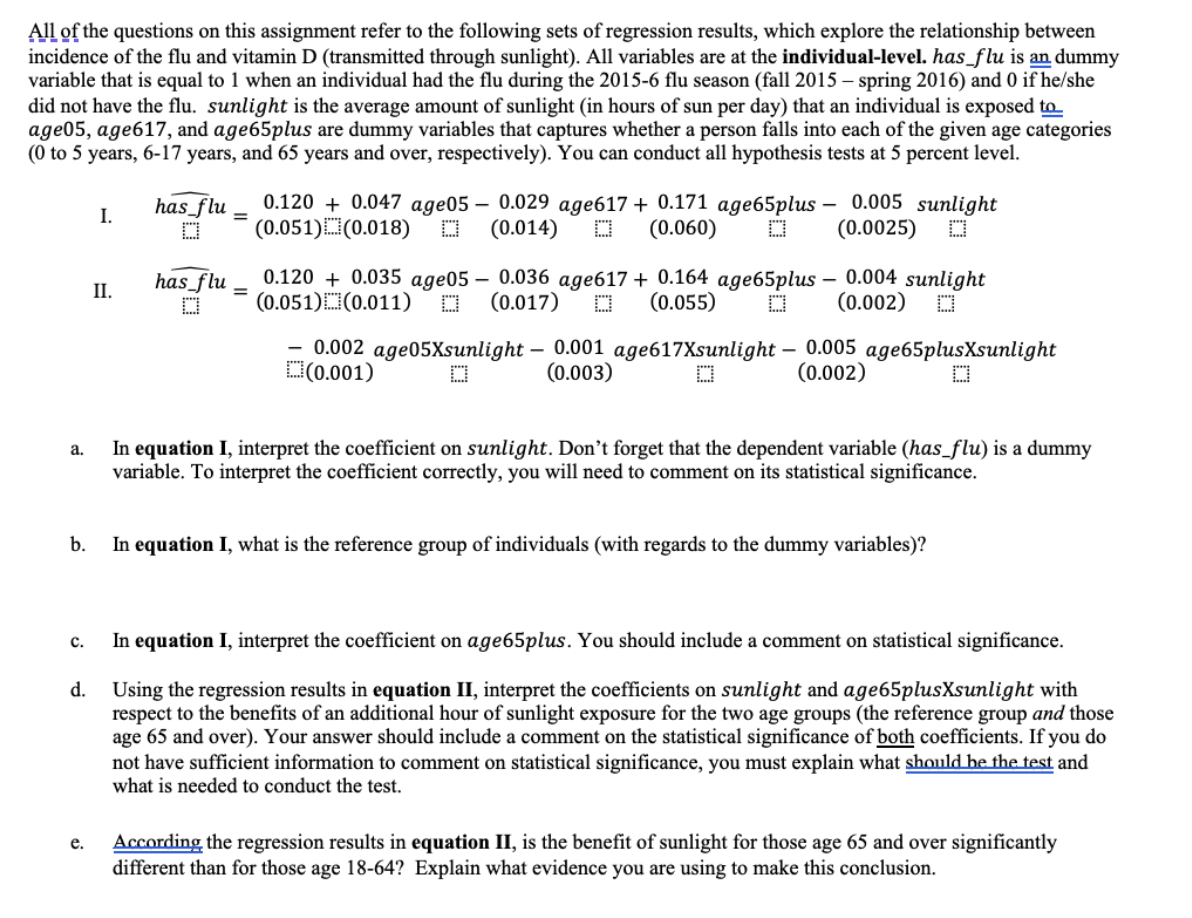
All of the questions on this assignment refer to the following sets of regression results, which explore the relationship between incidence of the flu and vitamin D (transmitted through sunlight). All variables are at the individual-level. has flu is an dummy variable that is equal to 1 when an individual had the flu during the 2015-6 flu season (fall 2015 spring 2016) and 0 if he/she did not have the flu. sunlight is the average amount of sunlight (in hours of sun per day) that an individual is exposed to age05, age617, and age65plus are dummy variables that captures whether a person falls into each of the given age categories (0 to 5 years, 6-17 years, and 65 years and over, respectively). You can conduct all hypothesis tests at 5 percent level. has_f lu I. 0.120 + 0.047 age05 - 0.029 age617 + 0.171 age65plus 0.005 sunlight (0.051)D(0.018) 0 (0.014) (0.060) O (0.0025) II. has flu O 0.120 + 0.035 age05 0.036 age617 + 0.164 age65plus - 0.004 sunlight (0.051) D(0.011) (0.017) (0.055) O (0.002) 0.002 age05Xsunlight :- 0.001 age617Xsunlight 0.005 age65plusXsunlight D(0.001) 0 (0.003) (0.002) O a. In equation I, interpret the coefficient on sunlight. Don't forget that the dependent variable (has_flu) is a dummy variable. To interpret the coefficient correctly, you will need to comment on its statistical significance. b. In equation I, what is the reference group of individuals (with regards to the dummy variables)? c. In equation I, interpret the coefficient on age65plus. You should include a comment on statistical significance. d. Using the regression results in equation II, interpret the coefficients on sunlight and age65plusXsunlight with respect to the benefits of an additional hour of sunlight exposure for the two age groups (the reference group and those age 65 and over). Your answer should include a comment on the statistical significance of both coefficients. If you do not have sufficient information to comment on statistical significance, you must explain what should be the test and what is needed to conduct the test. e. According the regression results in equation II, is the benefit of sunlight for those age 65 and over significantly different than for those age 18-64? Explain what evidence you are using to make this conclusion. All of the questions on this assignment refer to the following sets of regression results, which explore the relationship between incidence of the flu and vitamin D (transmitted through sunlight). All variables are at the individual-level. has flu is an dummy variable that is equal to 1 when an individual had the flu during the 2015-6 flu season (fall 2015 spring 2016) and 0 if he/she did not have the flu. sunlight is the average amount of sunlight (in hours of sun per day) that an individual is exposed to age05, age617, and age65plus are dummy variables that captures whether a person falls into each of the given age categories (0 to 5 years, 6-17 years, and 65 years and over, respectively). You can conduct all hypothesis tests at 5 percent level. has_f lu I. 0.120 + 0.047 age05 - 0.029 age617 + 0.171 age65plus 0.005 sunlight (0.051)D(0.018) 0 (0.014) (0.060) O (0.0025) II. has flu O 0.120 + 0.035 age05 0.036 age617 + 0.164 age65plus - 0.004 sunlight (0.051) D(0.011) (0.017) (0.055) O (0.002) 0.002 age05Xsunlight :- 0.001 age617Xsunlight 0.005 age65plusXsunlight D(0.001) 0 (0.003) (0.002) O a. In equation I, interpret the coefficient on sunlight. Don't forget that the dependent variable (has_flu) is a dummy variable. To interpret the coefficient correctly, you will need to comment on its statistical significance. b. In equation I, what is the reference group of individuals (with regards to the dummy variables)? c. In equation I, interpret the coefficient on age65plus. You should include a comment on statistical significance. d. Using the regression results in equation II, interpret the coefficients on sunlight and age65plusXsunlight with respect to the benefits of an additional hour of sunlight exposure for the two age groups (the reference group and those age 65 and over). Your answer should include a comment on the statistical significance of both coefficients. If you do not have sufficient information to comment on statistical significance, you must explain what should be the test and what is needed to conduct the test. e. According the regression results in equation II, is the benefit of sunlight for those age 65 and over significantly different than for those age 18-64? Explain what evidence you are using to make this conclusion







